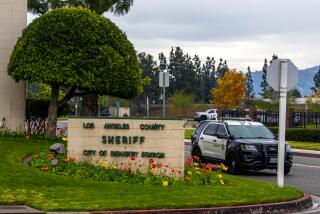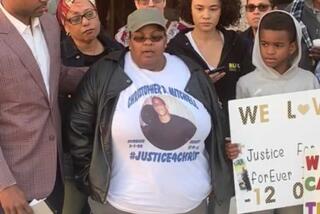Controversial Detention of a Slaying Suspect Was Proper, Court Rules
- Share via
In a decision certain to spark a third round of protracted appeals, a San Diego Superior Court judge ruled Tuesday that San Diego police officers acted properly in detaining Mark Alan Radke for the brutal 1988 slaying of a Mira Mesa teen-ager.
Even though one officer drew a revolver while detaining Radke at a traffic stop, that played no part in their detention of him and officers otherwise acted reasonably, Hayes said. Further, even though the officers put Radke in handcuffs while driving him downtown for questioning, it was reasonable to conclude that Radke voluntarily consented to the handcuffs, the judge said.
The case had drawn considerable public attention because of an earlier opinion by a state appeals court suggesting that police had not acted correctly at the traffic stop, violating Radke’s constitutional rights because Radke was detained without sufficient cause. That ruling appeared to make virtually all evidence in the case off-limits to prosecutors.
In this latest hearing on what evidence was admissible, victims’ rights groups and prosecutors feared that charges against Radke would have to be dismissed because of the constitutional rules on police procedure. Defense attorney Douglas C. Brown, meanwhile, worried that “community pressure” would result in a ruling unfavorable to Radke, accused in the January, 1988, slaying of 16-year-old Jeffrey Rudiger.
Defense to Appeal
Brown vowed a prompt appeal of the ruling. “I don’t believe the ruling was in compliance with (previous appellate) rulings and not in accord with the facts,” he said.
Deputy Dist. Atty. Thomas McArdle, however, predicted the decision would stand up on appeal and enable prosecutors to go forward with the case against Radke.
“I think the ruling was correct in all respects and unassailable,” McArdle said. “You can call it bulletproof if you like. (Radke) will undoubtedly seek review, but that review will not yield a different result, and we will go to trial.”
Rudiger, a student at Mira Mesa High School, disappeared after work on the night of Jan. 21, 1988. His handcuffed, partly clothed body was found the next day near a Scripps Ranch commercial center. Rudiger appeared to have been struck repeatedly with a hammer, and prosecutors say he was the victim of a sexual attack.
Radke, now 23, who had worked with Rudiger at a Chuck E. Cheese pizza parlor, became a suspect after co-workers told police the pair planned to meet the night Rudiger disappeared.
Hands Swollen, Cut
Detectives examining Radke’s car in the pizza parlor’s parking lot on Jan. 22 found that the tread from one tire resembled marks left in a pool of blood at the slaying site. Later, when handcuffing Radke at the traffic stop, officers noticed that Radke’s hands were swollen and cut, as if he had been in a fight.
Blood matching Rudiger’s type was found inside and on the exterior of the car and on Radke’s jacket.
Last summer, the 4th District Court of Appeal ruled that the officers’ conduct at Radke’s traffic stop violated his 4th Amendment right to protection from unreasonable searches and seizures. The justices said police had erred by placing Radke in handcuffs while taking him in for questioning and by drawing a revolver.
The ruling appeared to bar all evidence stemming from the stop. Prosecutors appealed to the California Supreme Court and the U.S. Supreme Court, but both declined to review the matter.
This February, both sides returned to San Diego Superior Court for a hearing on what evidence remained admissible. Brown asked Judge J. Perry Langford to suppress all evidence against Radke and to dismiss the case.
Langford declined, saying he viewed the traffic stop as lawful. But he also rejected prosecutors’ request to use previously unheard police testimony.
Both sides appealed that ruling. In a decision issued March 30, the 4th District gave prosecutors the right to introduce the new testimony.
How Much Testimony?
One of the issues Hayes had to decide was how much new testimony to allow, and he conceded Tuesday that he allowed “evidence to cover the waterfront,” including extensive testimony from Jerry E. Wiggins and James R. Manis, the officers who stopped Radke.
That evidence, the judge said, showed that whatever police obtained after the traffic stop was legally acquired. Officers had probable cause to arrest Radke, and even if they didn’t, he voluntarily consented to go downtown, the judge said, citing the two primary methods by which police may legally acquire evidence.
Officers had probable cause--or a “strong suspicion” that the person is guilty of a crime--to arrest Radke before they ever saw him at the traffic stop, Hayes said. Particularly critical was the tire print, which Hayes called “almost a carbon copy” of the tire on Radke’s car.
Though Wiggins conceded that he drew his revolver, the officer kept it along his right leg, below the field of vision from the driver’s seat window, so Radke could not have seen it, Hayes said. That meant the gun played no part in the stop, the judge said.
Even if the officers had no probable cause, Radke voluntarily consented to go downtown and even to wearing the handcuffs on the way there, Hayes said. Radke understood he was not under arrest, because he had asked, but allowed the cuffs when one of the officers said it was department policy that he wear them, Hayes said.
Hayes’ finding that there was probable cause or consent, if it stands on appeal, means Brown could no longer argue that the evidence must be barred for constitutional reasons. The lawyer could, however, seek other ways to exclude the evidence.
Radke remains free on $200,000 bail.
More to Read
Sign up for Essential California
The most important California stories and recommendations in your inbox every morning.
You may occasionally receive promotional content from the Los Angeles Times.













